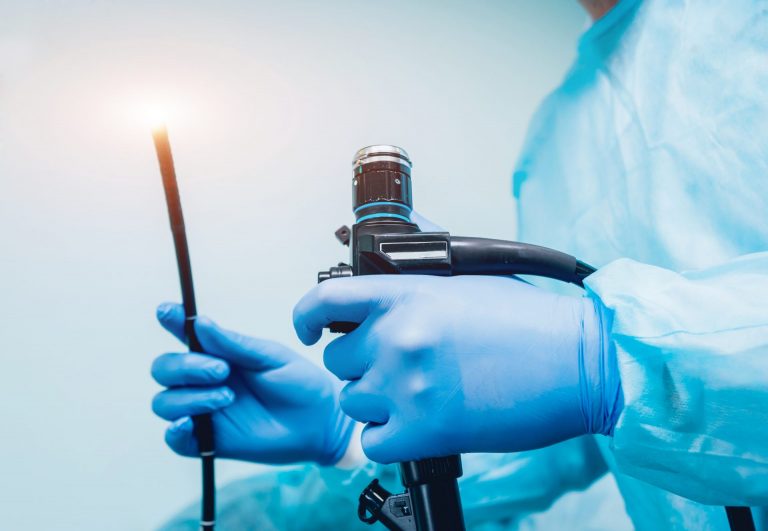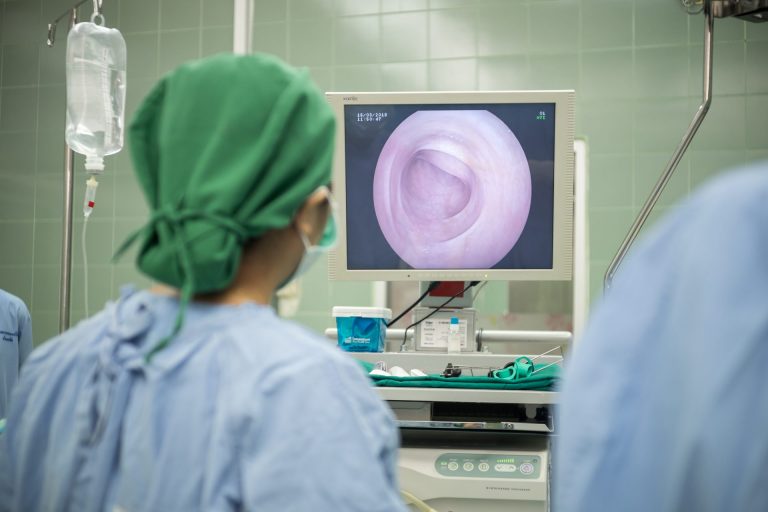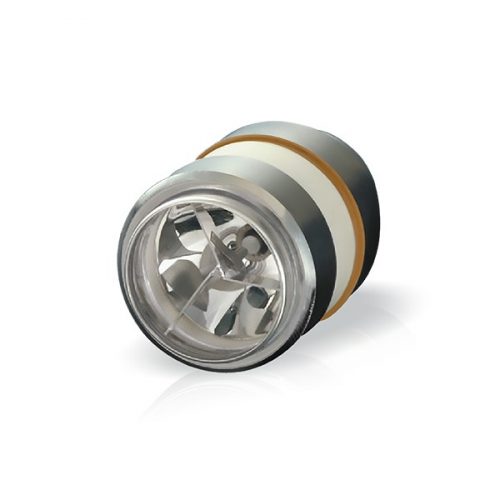Endoscopy and Borescopy Solutions
Ushio’s tiny xenon short arc lamps are used in medical devices, such as endoscopes, as well as industrial borescopes. Over time, continual improvement to its endoscopy illumination solutions has led to the success of Ushio’s UXR series.
Inside the human body, the colour rendering required by medical practitioners is an intense, pure white. The benefit of this type of light is not only image clarity but the ability to quickly distinguish between organs and blood vessels. The illumination component of an endoscope is pivotal in the detection of any irregularities within the patient’s body.
Ushio’s conventional endoscope lamps have functioned on 300 W in order to achieve the desired luminance; however, the UXR-300ES lamps have since lowered the required wattage by 14% to 260 W. This reduction has not been detrimental to the lamp’s luminance; in fact, the lumen maintenance has increased by 10% over the same 500 hour lifetime.
Another innovative quality of Ushio’s UXR endoscopy lamp series is the unique anti-window damage design. Other lamps have a glass window which protrudes from the device. This can lead to contact surface damage and contamination. The receded design of the UXR window means that the window cannot be scratched even if placed face down on a surface.
Not only is the window protected by the construction of the lamp, but the 25.4 mm window itself is made from sapphire. Sapphire is renowned as an optical material of immense durability, with a scratch resistance surpassed only by pure diamond. This makes the UXR series a hard-wearing, burst-resistant lamp of the highest quality.
Should you require, Ushio Europe can also unify your light source with a low wattage power source, thanks to our proprietary low wattage DC power supplies.
Beneficial qualities of Ushio's UXR xenon endoscope lamps
- Superior lumen maintenance
- Broad wavelength spectrum
- Built-in mirror / reflector negates the need for optical axis adjustment
- Ceramic base for safe isolation and durability
- Compact and lightweight
- Easy installation – no need to worry about heat sink positioning
- High shock and pressure resistance
- Sapphire window for added burst resistance
- Superior lumen maintenance
- World-renowned Japanese reliability and usability


Applications for Ushio's UXR lamps
- High-luminance projectors
- Industrial borescopes
- Light source for fibre illumination
- Light source for fibre optic inspection image processing
- Medical endoscopes
- Microscope illumination
- Solar simulation
- Spectroscopic analysis
- Visible and infrared searchlights
What is the difference between an endoscope and a borescope?
Endoscopes
Endoscopes are tubular devices, usually only a few millimetres thick, which can be used to look inside a body without having to perform invasive surgery.
The prefix endo- comes from the Greek word for “inside” or “within”. The suffix -scope derives from the word “skopos”, which means “to observe” in Greek.
Early endoscopes, with their sequences of lenses and mirrors, were not too dissimilar from the periscopes used on maritime and submarine vessels.
Modern endoscopes consist of primarily of illuminated fibre optics, a light source, a video capture component, and a display for the medical professional to view.
The fibre optics hold a dual purpose as they transport light to the distal tip (the end furthest from the user) and send real-time images back to the operator at the proximal tip.
Endoscopes play a vital role in diagnosis procedures, but also take part in slightly more invasive treatments such as keyhole surgery. In those scenarios, a modified endoscope called a laparoscope enters the body through a small incision. This special technology has been credited with vastly reducing blood loss and recovery time of patients.
Borescopes
While the term endoscope is familiar due to its impact on medical science, the term borescope actually covers all such devices. An endoscope is a type of borescope which has been designed with human medical applications in mind.
Consequently, devices referred to as borescopes, or boroscopes, are generally deployed in industrial applications. As with an endoscope, borescope devices are designed to enter and visualise spaces which are otherwise inaccessible without needing to dismantle equipment or cause damage.
The suffix bore- means “to make a cylindrical cavity” and is present in many European languages. The origins of the word bore are believed to be Proto-Germanic and a relation to the modern German “bohren”.
In particular, borescopes are used in the automotive, aviation, and locomotive industries as a method of non-destructive engine inspection. Traditionally featuring a rigid arm and a fixed camera for image capture, some borescopes may feature a flexible structure or a soft, cable-like design.
Many borescopes are fitted with an external display, however many still carry an eyepiece. Alternative names and types of borescopes include fiberscopes, videoscopes, and inspection cameras.
Common endoscopic procedures
- Arthroscopy
- Bronchoscopy
- Colonoscopy
- Cystoscopy
- Enteroscopy
- Gynoscopy
- Hysteroscopy
- Laparoscopy
- Laryngoscopy
- Mediastinoscopy
- Otoscopy
- Sigmoidoscopy
- Thoracoscopy / pleuroscopy
- Upper gastrointestinal endoscopy / esophagogastroduodenoscopy (EGD)
- Ureteroscopy
Major industries using borescopes
- Automotive
- Aviation
- Borehole inspection
- Chemical processing
- Corrosion detection
- Heating, ventilation, and air conditioning (HVAC) system maintenance
- Locomotive
- Manufacturing
- Metal casting
- Oil and gas pipeline maintenance
- Sanitation
- Search and rescue
- Heat exchange pipe inspection
- Turbine inspection
- Power generation industry
Ushio is ready to accept your UXR endoscope and borescope lamp enquiries
If you would like to know more about Ushio’s UXR lamps and their associated low wattage power supplies, please make your way to our contact page where we will be happy to accept your enquiry.
To receive the latest Ushio Europe product brochures, please visit our downloads page.
To begin your product enquiries, please fill in the form on our contact page.


